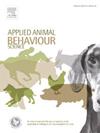The influence of an unfamiliar person’s presence on shelter use, feeding, and exploratory behavior in domestic rabbits during animal-assisted interventions
IF 2
2区 农林科学
Q1 AGRICULTURE, DAIRY & ANIMAL SCIENCE
引用次数: 0
Abstract
Rabbits have been increasingly used in Animal-Assisted Interventions (AAI) in recent years. The issue of their welfare during these interventions, however, remains insufficiently explored. The common practice of holding a rabbit on the client’s lap often leads to signs of stress. An alternative could be the use of a therapeutic table which allows for partial movement and provides a hiding place. This study aimed to analyze rabbits’ behavior during AAI and determine whether the therapeutic table represents an appropriate compromise for ensuring their well-being, or whether a no-contact approach with the client would be more suitable. The study included 9 female domestic rabbits habituated to human handling and 4 children, aged 9–11 years, unknown to the rabbits. A randomized controlled within-subject design with repeated measures was used. Each rabbit was tested twice in two different conditions: either on a specially adapted table with a hiding place in the presence of a child or without the presence of a child. A total of 36 sessions, each lasting 10 min, were conducted. The use of the hiding place, exploratory behavior, and feed intake were monitored, with all sessions video-recorded and later analyzed using Observer XT software. Statistical analysis was performed using R software (version 4.3.3; unction glmer in lme4 package and nlme package). The results showed that the rabbits spent on average three times more in the shelter during therapeutic sessions when a child was present compared to sessions without a child (F1,34 = 2.051; p = 0.051). Rabbits displayed exploratory activity significantly less (F1,34 = 6.308; p < 0.0001) in the presence of a child, whereas in his absence, this time increased. Additionally, we observed a significant reduction in feed intake: in the presence of a child, the rabbits ate in less than 20 % of the observation time, while in the control group, feed intake was recorded in more than 80 % of the observation time (F1,34 = 2.709; p = 0.007). The findings suggest that even though the therapeutic table provided hiding opportunities and allowed for movement, it did not fully mitigate the negative impact of the unfamiliar child’s presence on the rabbits’ welfare during AAI. These insights must be considered when planning and conducting these interventions, taking into account the welfare of the participating animals.
在动物辅助干预中,不熟悉的人的存在对家兔的庇护所使用、喂养和探索行为的影响
近年来,兔子越来越多地用于动物辅助干预(AAI)。然而,在这些干预期间,他们的福利问题仍然没有得到充分探讨。把兔子放在病人腿上的常见做法往往会导致压力的迹象。另一种选择是使用治疗桌,它允许部分运动,并提供一个隐藏的地方。本研究旨在分析兔子在AAI期间的行为,并确定治疗桌是否代表了确保它们健康的适当妥协,或者与客户不接触的方法是否更合适。研究对象包括9只习惯人类操作的雌性家兔和4只家兔不认识的9 - 11岁儿童。采用重复测量的随机对照试验设计。每只兔子都在两种不同的条件下进行了两次测试:一种是在一个特殊的桌子上,在孩子在场的情况下有一个藏身之处,另一种是没有孩子在场。总共进行了36次会议,每次持续10 分钟。研究人员对藏身处的使用、探索行为和采食量进行了监控,并将所有过程都录了下来,随后使用Observer XT软件进行分析。采用R软件(版本4.3.3;函数在lme4包和nlme包中闪烁)。结果表明,在有孩子的治疗期间,兔子在收容所的平均花费是没有孩子的治疗期间的三倍(F1,34 = 2.051; = 0.051页)。兔的探索活动显著减少(F1,34 = 6.308;P <; 0.0001),而在孩子不在场的情况下,这个时间增加了。此外,我们还观察到采食量的显著减少:在有孩子的情况下,兔子的采食量在观察时间的20% %以下,而在对照组,采食量在观察时间的80% %以上(F1,34 = 2.709; = 0.007页)。研究结果表明,即使治疗桌提供了隐藏的机会,并允许兔子移动,但它并不能完全减轻不熟悉的孩子在AAI期间对兔子福利的负面影响。在计划和实施这些干预措施时,必须考虑到这些见解,并考虑到参与动物的福利。
本文章由计算机程序翻译,如有差异,请以英文原文为准。
求助全文
约1分钟内获得全文
求助全文
来源期刊

Applied Animal Behaviour Science
农林科学-行为科学
CiteScore
4.40
自引率
21.70%
发文量
191
审稿时长
18.1 weeks
期刊介绍:
This journal publishes relevant information on the behaviour of domesticated and utilized animals.
Topics covered include:
-Behaviour of farm, zoo and laboratory animals in relation to animal management and welfare
-Behaviour of companion animals in relation to behavioural problems, for example, in relation to the training of dogs for different purposes, in relation to behavioural problems
-Studies of the behaviour of wild animals when these studies are relevant from an applied perspective, for example in relation to wildlife management, pest management or nature conservation
-Methodological studies within relevant fields
The principal subjects are farm, companion and laboratory animals, including, of course, poultry. The journal also deals with the following animal subjects:
-Those involved in any farming system, e.g. deer, rabbits and fur-bearing animals
-Those in ANY form of confinement, e.g. zoos, safari parks and other forms of display
-Feral animals, and any animal species which impinge on farming operations, e.g. as causes of loss or damage
-Species used for hunting, recreation etc. may also be considered as acceptable subjects in some instances
-Laboratory animals, if the material relates to their behavioural requirements
 求助内容:
求助内容: 应助结果提醒方式:
应助结果提醒方式:


